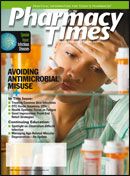Publication
Article
Pharmacy Times
Avoiding Antimicrobial Misuse: Delaying the Postantibiotic Era
Author(s):
Appropriate antimicrobial use is critical because almost 70% of bacterial infections resulting in death are resistant to at least one antimicrobial.
Dr. Jung is a clinical assistant professorat Ernest Mario School of Pharmacy,Rutgers, The State University of NewJersey, and an infectious diseases clinicalspecialist at Robert Wood JohnsonUniversity Hospital.

Antibiotic resistance becamea pressing issue the momentAlexander Fleming discoveredpenicillin in the early 1940s,but never more so than today. As weenter a time that some fear may bethe "postantibiotic era,"1 appropriateantimicrobial use is even morecritical than ever. Approximately 70%of bacterial infections resulting inmortality are resistant to at leastone antimicrobial, and complicationsresulting from drug-resistant infectionscost society almost $5 billionannually, according to estimates bythe Centers for Disease Control andPrevention (CDC).2
"No Drugs"
Up until the last decade, bacterial resistanceto antimicrobials has only ledto further research and developmentof novel drugs to counteract some ofthis resistance. A 2004 report by theInfectious Diseases Society of America(IDSA), Bad bugs, No drugs, highlightsthe alarming fact that the formerly prodigiousantibiotic pipeline is now dryingup. Only 3 novel antibiotics havecome onto the market in the last 11years, and only one of those has activityagainst gram-negative organisms, wherethe greatest need for a novel antibioticagent lies.2 Sadly, as much as societywould like to believe that health careand the pharmaceutical industry are abasic human right, it is, at the end of theday, still a business.2,3
Antibiotics often provide a weakinvestment return, because they areusually only prescribed for 3 to 14 daysfor most infections, 6 weeks for moresevere infections, such as endocarditisand osteomyelitis, and rarely for longerthan that timeframe. In addition, thetrend in recommendations for therapeuticduration is crawling toward shorteningtherapies as much as possible tocombat rising resistance issues.3 Withthe large amount of resources requiredfor the research and development ofa new drug, many companies preferdeveloping drugs that will be takenchronically, as they bring more promiseof investment return.2
Bad Bugs
On the opposing end, bacteria havebeen quickly and steadily increasingtheir resistance armamentarium. In theearly 1980s, the first extended-spectrumbeta-lactamases were identified, mostof which conferred resistance to, functionally,the entire beta-lactam classexcept carbapenems. By the late 1980s,the AmpC class of beta-lactamasesemerged, which also conferred resistanceto most of the beta-lactam class,but again, spared the carbapenems.4
In the earlier part of this century,however, an epidemic of what is nowidentified as the Klebsiella pneumoniaeCarbapenemase (KPC) classspread throughout New York City andsome surrounding areas. These KPCsconferred resistance to not only theentire beta-lactam class, including carbapenems,but demonstrated resistancetoward many other classes of antibioticsas well, including fluoroquinolones,aminoglycosides, tetracyclines, etc.5-7As a result, hospitals worldwide havebeen battling aptly named multidrugresistantorganisms, while new resistancemechanisms, such as CTX-M,are being identified much more rapidlythan novel agents are being developedto counter them.2,8
Battling the Resistance
With the barrenness of the antibioticpipeline in terms of novel antimicrobialagents to combat growing resistance,different strategies have been employedas an attempt at curtailing this problemof resistance—strategies that havelargely failed thus far.
One popular method is to "doublecover" highly resistant organisms, evenafter susceptibilities are known. Unfortunately,very little, if any, data showany benefit resulting from this method.Either the organism has or will developresistance to one or more of the agentsused, or agents used will co-select resistanceto other classes of antibiotics.3,9The bottom line is that greater use ofantibiotics results in greater probabilityof resistance emergence.
Another failed attempt is antibioticcycling. This is when one antibiotic ischosen as the antibiotic of choice or"workhorse" antibiotic for certain infectionsuntil susceptibilities to that agentdecline. Another agent is then selectedas the new agent of choice to let thesusceptibilities of the original workhorserecover. Rice et al humorously, yet accurately,point out that this type of managementis "like offering an alcoholicthe choice to rotate beer, wine, gin, andwhiskey as a strategy to prevent liverdisease."3
Strategies for Clinicians
The most effective strategy to combatthe emergence of resistant bacteria is toencourage the appropriate use of antibiotics—start at the right time, and stopat the right time. Development of resistancedepends largely on inappropriatedoses of drug, inappropriate durationsof treatment, inappropriate exposures toantibiotics, and inappropriate selectionof antibiotics used.10
Starting properly dosed antibiotics atthe right time is vital in treating patientswith true infections and preventing exposurein those patients who do notrequire antibiotic therapy. Although dataare showing decreased mortality whenantibiotics are administered as soon aspossible to patients with severe andoverwhelming bacterial infection, antibioticsshould not be prescribed wherethere is a low suspicion of bacterialinfection.
In the outpatient setting, approximately55% of all antibiotics prescribed foracute respiratory tract infections wereunnecessary due to the viral nature ofmany of these infections.10 This largepercentage of inappropriate use of antibioticsfueled a study by Dagan et al,which demonstrated decreased resistancerates with decreased inappropriateantibiotic use in children with acuteotitis media.11
Currently, the CDC is involved inencouraging appropriate prescribing ofantibiotics through their Get Smart campaign.This program promotes appropriateprescribing, decreasing demandfor antibiotics by the general public,and proper adherence and duration oftherapy once an antibiotic is initiatedappropriately.10
Discontinuation of antibiotics at theappropriate end point is the secondand perhaps the more difficult conceptto encourage, yet the most effective.Because there are not enough datasupporting current durations of treatmentnor a lot of data supporting theshortening of current durations of treatment,practitioners are often caughtbetween the fear of undertreating apatient and the fear of promoting bacterialresistance by overtreating them.3,12De-escalation of empiric therapy tonarrow-spectrum therapy once identificationand susceptibility of an organismis known is one practical way ofdiscontinuing broad-spectrumantibioticsappropriately. Followingend pointsrecommended by guidelines put forthby the IDSA also is one way to remainconsistent in practice.
Determining appropriate treatmentwill be an exercise in determining whenthe period of adequate treatment endsand the period of increasing antimicrobialselective pressure begins. To furthercomplicate this issue, adequate treatmentfor the same disease state maydiffer between those patients who areimmunocompetent and those who areimmunocompromised, such as patientswho are neutropenic. Clearly, more prospectivestudies are needed in this areabefore definitive end points of therapycan be enforced.
References
- Falagas ME, Bliziotis IA. Pandrug-resistant Gram-negative bacteria: Dawn of the post-antibiotic era? Int J of Antimicrob Agents. 2007;29(6):630-636.
- Bad bugs, no drugs: As antibiotic discovery stagnates?A public health crisis brews Infectious Diseases Society of America Web site. www.idsociety.org/badbugsnodrugs.html. Accessed Dec 1, 2008.
- Rice LB. The Maxwell Finland Lecture: For the duration?rational antibiotic administration in an era of antimicrobial resistance and clostridium difficile. Clin Infect Dis. 2008;46(4):491-496.
- Thomson KS. Controversies about extended-spectrum and AmpC beta-lactamases. Emerg Infect Dis. 2001;7(2):333-336.
- Yigit H, Queenan AM, Anderson G, et al. Novel carbapenem-hydrolyzing beta-lactamase, KPC-1, from a carbapenem-resistant strain of Klebsiella pneumonia. Antimicrob Agents and Chemother. 2001;45(4):1151-1161.
- Woodford N, Tierno PM Jr, Young K, et al. Outbreak of Klebsiella pneumoniae producing a new carbapenem-hydrolyzing class A beta-lactamase, KPC-3, in a New York medical center. Antimicrob Agents Chemother. 2004;48(12):4793-4799.
- Smith Moland E, Hanson ND, Herrera VL, et al. Plasmid-mediated, carbapenem-hydrolysing beta-lactamase, KPC-2, in Klebsiella pneumoniae isolates. J Antimicrob Chemother. 2003;51(3):711-714.
- Lewis JS 2nd, Herrera M, Wickes B, Patterson JE, Jorgensen JH. First report of the emergence of CTX-M-type extended-spectrum beta-lactamases (ESBLs) as the predominant ESBL isolated in a US health care system. Antimicrob Agents Chemother. 2007;51(11):4015-4021.
- Mandell GL, Bennett JE, Dolin R, eds. In: Mandell, Bennett, & Dolin: Principles and Practice of Infectious Diseases. 6th ed. Philadelphia, PA: Churchill Livingstone; 2005:2600-2608.
- Friedman CR, Whitney CG. It?s time for a change in practice: reducing antibiotic use can alter antibiotic resistance. J Infect Dis. 2008;197(8):1082-1083.
- Dagan R, Barkai G, Givon-Lavi N, et al. Seasonality of antibiotic-resistant streptococcus pneumoniae that causes acute otitis media: A clue for an antibiotic-restriction policy? J Infect Dis. 2008;197(8):1094-1102.
- Bronzwaer SL, Cars O, Buchholz U, et al. A European study on the relationships between antimicrobial use and antimicrobial resistance. Emerg Infect Dis. 2002;8(3):278-282.







